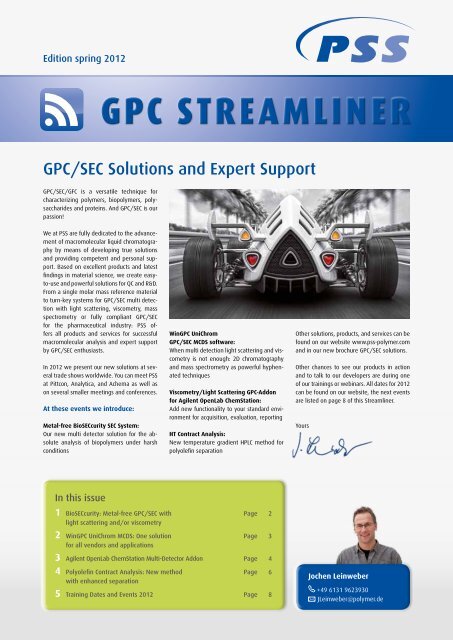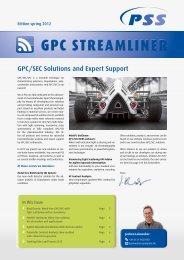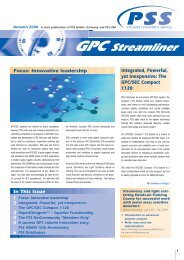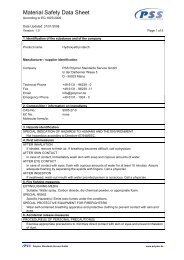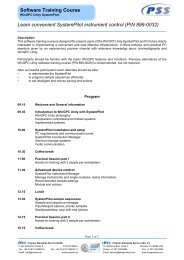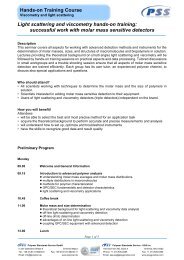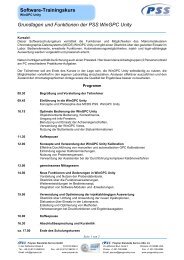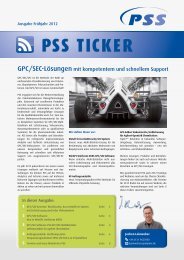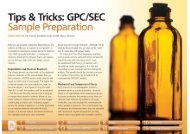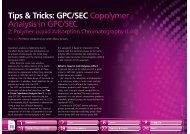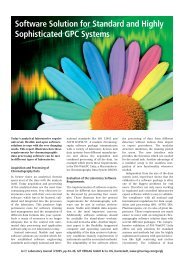GPC STREAMLINER - PSS
GPC STREAMLINER - PSS
GPC STREAMLINER - PSS
- TAGS
- streamliner
- polymer.de
Create successful ePaper yourself
Turn your PDF publications into a flip-book with our unique Google optimized e-Paper software.
Edition spring 2012<br />
<strong>GPC</strong>/SEC Solutions and Expert Support<br />
<strong>GPC</strong>/SEC/GFC is a versatile technique for<br />
characterizing polymers, biopolymers, polysaccharides<br />
and proteins. And <strong>GPC</strong>/SEC is our<br />
passion!<br />
We at <strong>PSS</strong> are fully dedicated to the advancement<br />
of macromolecular liquid chromatography<br />
by means of developing true solutions<br />
and providing competent and personal support.<br />
Based on excellent products and latest<br />
findings in material science, we create easyto-use<br />
and powerful solutions for QC and R&D.<br />
From a single molar mass reference material<br />
to turn-key systems for <strong>GPC</strong>/SEC multi detection<br />
with light scattering, viscometry, mass<br />
spectrometry or fully compliant <strong>GPC</strong>/SEC<br />
for the pharmaceutical industry: <strong>PSS</strong> offers<br />
all products and services for successful<br />
macromolecular analysis and expert support<br />
by <strong>GPC</strong>/SEC enthusiasts.<br />
In 2012 we present our new solutions at several<br />
trade shows worldwide. You can meet <strong>PSS</strong><br />
at Pittcon, Analytica, and Achema as well as<br />
on several smaller meetings and conferences.<br />
At these events we introduce:<br />
<strong>GPC</strong> streamliner<br />
Metal-free BioSECcurity SEC System:<br />
Our new multi detector solution for the absolute<br />
analysis of biopolymers under harsh<br />
conditions<br />
Win<strong>GPC</strong> UniChrom<br />
<strong>GPC</strong>/SEC MCDS software:<br />
When multi detection light scattering and viscometry<br />
is not enough: 2D chromatography<br />
and mass spectrometry as powerful hyphenated<br />
techniques<br />
Viscometry/Light Scattering <strong>GPC</strong>-Addon<br />
for Agilent OpenLab ChemStation:<br />
Add new functionality to your standard environment<br />
for acquisition, evaluation, reporting<br />
HT Contract Analysis:<br />
New temperature gradient HPLC method for<br />
polyolefin separation<br />
In this issue<br />
1 BioSECcurity: Metal-free <strong>GPC</strong>/SEC with<br />
light scattering and/or viscometry<br />
Page 2<br />
2 Win<strong>GPC</strong> UniChrom MCDS: One solution<br />
for all vendors and applications<br />
Page 3<br />
3 Agilent OpenLab ChemStation Multi-Detector Addon Page 4<br />
4 Polyolefin Contract Analysis: New method<br />
with enhanced separation<br />
Page 6<br />
5 Training Dates and Events 2012 Page 8<br />
Other solutions, products, and services can be<br />
found on our website www.pss-polymer.com<br />
and in our new brochure <strong>GPC</strong>/SEC solutions.<br />
Other chances to see our products in action<br />
and to talk to our developers are during one<br />
of our trainings or webinars. All dates for 2012<br />
can be found on our website, the next events<br />
are listed on page 8 of this Streamliner.<br />
Yours<br />
Jochen Leinweber<br />
+49 6131 9623930<br />
jLeinweber@polymer.de
Figure 1<br />
2<br />
System Solutions<br />
BioSECcurity, the metal-free <strong>GPC</strong>/SEC solution<br />
with light scattering and/or viscometry<br />
Routine bioanalysis under harsh conditions<br />
has never been so easy and powerful. With<br />
the BioSECcurity SEC System, <strong>PSS</strong> introduces<br />
the ideal solution for protein molar mass, purity,<br />
and aggregation analysis with advanced<br />
detection.<br />
Problems in biopolymer analysis are often<br />
caused by corrosion due to the required high<br />
salt concentrations and the extreme pH values.<br />
In addition, metal ions can lead to problems<br />
with the column lifetime or chromatographic<br />
artifacts.<br />
BioSECcurity overcomes these problems by<br />
offering a metal-free system comprising:<br />
a quaternary pump with active seal wash<br />
a high performance autosampler for wellplates<br />
or vials or alternatively a manual<br />
injector<br />
a multi wavelength UV detector or DAD/PDA<br />
a right angle multichrom light scattering<br />
detector SLD1000B (RALLS) or alternatively<br />
a multi angle light scattering detector<br />
SLD7000B (MALLS)<br />
an ETA2010B online viscometer<br />
an analytical fraction collector for wellplates,<br />
test tubes, or vials<br />
The two light scattering detectors offered differ<br />
in the number of supported angles. While<br />
the RALLS detector measures the scattered<br />
light at 90°, the MALLS detector measures<br />
the scattering intensity simultaneously at 7<br />
angles between 35° and 145°.<br />
For many porteins, especially globular proteins,<br />
the RALLS detector is sufficient. The<br />
major advantage of this detector over others<br />
is the user selectable wavelength for highest<br />
sensitivity even at low molar masses or<br />
concentrations.<br />
The MALLS detector has to be used to determine<br />
the molar mass of anisotropic scatterers<br />
correctly or if the radius of gyration needs to<br />
be measured.<br />
Wetted materials in this system are PEEK,<br />
PEKK, PTFE, Titanium, Gold, Platin-Iridium and<br />
Sapphire. Depending on the configuration the<br />
system can withstand pH values from 1-13<br />
(1 day: 14) or 1-12 if the RALLS detector is<br />
used.<br />
Gamma-Globulin sample (monomer with dimer) detected using a UV detector and the<br />
7 angle MALLS detector (4 angles not displayed)<br />
The following columns with PEEK hardware<br />
are available:<br />
PROTEEMA Precolumn 8*50<br />
PROTEEMA with different particle sizes and<br />
the porosities 100 Å, 300 Å and 1000Å.<br />
Other materials on request.<br />
Instrument control, data acquisition and<br />
analysis is achieved with Win<strong>GPC</strong> UniChrom<br />
MCDS. More details on UniChrom can be<br />
found at page 3.<br />
Ideal applications for the system are protein<br />
molar mass, purity, and aggregation analysis.<br />
Here the addition of a light scattering detector<br />
adds new possibilities. This molar mass<br />
sensitive detector allows the determination<br />
of absolute molar masses without column<br />
calibration. Aggregates can be detected with<br />
superior sensitivity as shown in figure 1.<br />
Dr. Daniela Held<br />
+49 6131 9623933<br />
DHeld@polymer.de
Figure 1<br />
<strong>GPC</strong>/SEC Software<br />
New in Win<strong>GPC</strong> UniChrom <strong>GPC</strong>/SEC MCDS software<br />
Win<strong>GPC</strong> UniChrom is a macromolecular chromatography<br />
data system (MCDS) supporting<br />
all methods in (bio)polymer characterization<br />
with controls for many vendors. It is the successor<br />
of the well-known Win<strong>GPC</strong> Unity software<br />
and comes with all Unity features and<br />
modules as well as many new options and<br />
functions. The most important new developments<br />
are shortly introduced in this article:<br />
The ChromPilot for comprehensive instrument<br />
control and powerful sequence<br />
management<br />
The Project Manager for modern sample<br />
management and fast access to data with<br />
less mouse clicks<br />
The Mass Spectrometry Modul for the<br />
analysis of <strong>GPC</strong>/SEC-MS data and determination<br />
of absolute molar masses for low<br />
molar mass samples<br />
ChromPilot<br />
With the release of Win<strong>GPC</strong> UniChrom and<br />
ChromPilot in November 2011, <strong>PSS</strong> has a system<br />
at hand that can easily incorperate controls<br />
for LC systems independent of brand.<br />
The flexible driver concept allows the fast<br />
and seamless addition of new systems eliminating<br />
the need to re-install and re-configure<br />
Win<strong>GPC</strong> UniChrom, when control for another<br />
system is added.<br />
The ChromPilot for comprehensive system control<br />
for many vendors. The concept is driver based,<br />
new drivers March 2012: Waters Alliance and <strong>PSS</strong><br />
BioSECcurity SEC System.<br />
In March 2012 the following systems and<br />
detectors are supported by ChromPilot:<br />
<strong>PSS</strong> SECcurity <strong>GPC</strong> System<br />
<strong>PSS</strong> BioSECcurity SEC System<br />
(New March 2012)<br />
Figure 2<br />
The new Win<strong>GPC</strong> UniChrom Project Manager with the containers<br />
saves mouse clicks and offers a data preview.<br />
HP/Agilent 1100 System<br />
Agilent 1200/1260/1290 System<br />
Agilent 1120/1220 System<br />
Dionex UHPLC+ Focused, UltiMate 3000<br />
Shimadzu Nexera, Prominence,<br />
LC-8/10/20A<br />
Shodex RI 100/200<br />
Tosoh EcoSEC semi-micro <strong>GPC</strong> System<br />
Waters Alliance (New March 2012)<br />
Wyatt DAWN DSP, DAWN EOS, Mini-Dawn<br />
New drivers are constantly developed and<br />
added.<br />
The ChromPilot offers a number<br />
of advantages:<br />
Users can select the best instrument and<br />
the best software solution for their needs<br />
and still be sure that handling errors are<br />
avoided and compliance issues are met.<br />
Mixed configurations, e.g. pump, autosampler,<br />
and detectors from different vendors,<br />
are fully supported.<br />
The sequence manager and user interface<br />
are always the same, independent on the<br />
system used. This minimizes the requirement<br />
for training and makes <strong>GPC</strong>/SEC<br />
easy-to-use.<br />
The sequence manager does not only allow<br />
to program injections. It reflects the<br />
workflow in the lab by adding sequence<br />
commands that allow to change the flowrate,<br />
the UV detector wavelength, the<br />
instrument or Win<strong>GPC</strong> method and other<br />
parameters during the sequence.<br />
The instrument manager shows a concise<br />
and clear summary of the most important<br />
parameters for all modules and allows to<br />
set comfortable end-actions.<br />
Therefore the ChromPilot is an indespensable<br />
tool making lab life easier.<br />
UniChrom Project Manager<br />
The amount of data in labs grows continuously<br />
and directory trees, especially in networks,<br />
get more convoluted. That makes<br />
data management complex and more tedious.<br />
The Win<strong>GPC</strong> sample search feature<br />
is already a big help to find relevant information.<br />
A more universal tool is the new<br />
Win<strong>GPC</strong> UniChrom Project Manager. Projects<br />
can be organized in user defined containers,<br />
which hold Win<strong>GPC</strong> projects independent of<br />
their file location. So various Win<strong>GPC</strong> projects<br />
can be organized without the need to<br />
remember the file and network path.<br />
Very useful is the comprehensive chromatogram<br />
preview and the filters which allow to<br />
show only a subset of sequences as specified<br />
in the filter definition. Data can be send<br />
directly from the Project Manager to the<br />
overlay which allows to create overlays<br />
quickly. There is no need to load any projects<br />
or sequences.<br />
Mass Spectrometry (MS) Module<br />
Light scattering is an accepted method to<br />
measure true molar masses. However, it has<br />
its limitations for low molar masses and for<br />
copolymers. Therefore, hyphenation of <strong>GPC</strong>/<br />
SEC with mass spectrometry (ESI-MS, MALDI-<br />
Is Win<strong>GPC</strong> UniChrom right for you?<br />
Arrange a personal web meeting with one<br />
of our experts. Based on your application<br />
requests and personal questions, we will<br />
show you features and functions that<br />
make your life easier!<br />
Contact info@polymer.de<br />
3
Figure 2<br />
4<br />
ToF) has become a new, valuable tool to<br />
measure true molar masses with high precision,<br />
that cannot be determined with any<br />
other method.<br />
The disadvantage of <strong>GPC</strong>/SEC-MS hyphenation,<br />
the complicated analysis especially<br />
when copolymers are present or when multiple<br />
charges per chain are possible, has<br />
been overcome with the development of<br />
the UniChrom Mass Spectrometry Module.<br />
Here, mass spectra (in the vendor independent<br />
mzXML format) can be imported to the<br />
corresponding Win<strong>GPC</strong> run. The spectra are<br />
analyzed automatically and require only the<br />
molar mass of the repetition unit (2 values<br />
<strong>GPC</strong>/SEC Software<br />
<strong>PSS</strong> <strong>GPC</strong>/SEC Multi-Detector Software for Agilent ChemStation<br />
The <strong>PSS</strong> Win<strong>GPC</strong> product family and Agilent’s<br />
ChemStation are very popular and widely<br />
used chromatography data systems for<br />
<strong>GPC</strong>/SEC and LC, respectively. A <strong>GPC</strong>/SEC addon<br />
for the ChemStation CDS, targeted for<br />
routine applications and limited to concentration<br />
detectors, is available. However, with the<br />
availability of light scattering (LS) and viscometry<br />
(DV) detectors in the Agilent product<br />
line after the acquisition of Polymer Labs/<br />
Varian, there is a need for a more featurerich<br />
ChemStation <strong>GPC</strong>/SEC addon, that also<br />
supports molar mass sensitive detectors.<br />
Based on the existing solution <strong>PSS</strong> took the<br />
lead and developed a fully integrated <strong>GPC</strong>/<br />
SEC addon which supports concentration<br />
detectors, every kind of LS (RALLS, TALLS,<br />
MALLS) detectors and online viscometry. In<br />
addition, the <strong>PSS</strong> Multi-Detector <strong>GPC</strong>/SEC ad-<br />
<strong>GPC</strong>/SEC data evalation settings support up to 6<br />
signals and conventional, LS, DV and triple detection<br />
systems<br />
in case of copolymers) and the molar mass<br />
of the ionization agent as user input. Isotope<br />
effects in the MS spectra are automatically<br />
corrected, the charge state in ESI spectra is<br />
automatically determined without any user<br />
interaction. This makes things easy also for<br />
non MS experts.<br />
The usability of the Win<strong>GPC</strong> MS module is<br />
very similar to the light scattering, viscometry<br />
and 2D modules and can be mastered<br />
without much effort or long-time training.<br />
The data analysis offers many features, depending<br />
on the MS technology employed.<br />
These include structure elucidation with<br />
MSn, ion-trap and MS-TOF instruments. Even<br />
Figure 1<br />
OpenLab CDS ChemStation with activated <strong>PSS</strong> <strong>GPC</strong>/SEC Multi-Detector Addon<br />
showing <strong>GPC</strong>/SEC data from an MDS390 with 2-angle LS and viscometry<br />
don offers all kinds of calibration and evaluation<br />
methods incl. narrow and broad standards,<br />
universal calibration, viscometry, light<br />
scattering and triple detection.<br />
Supported systems<br />
Agilent all 11x0,12x0 systems and<br />
modules, MDS390<br />
<strong>PSS</strong> all SECcurity systems and<br />
detectors<br />
other via Agilent<br />
detectors 35900E A/D converter<br />
Supported ChemStation revisions<br />
ChemStation all 32bit (B.01.01 to B.04.03)<br />
OpenLab all CDS CStn (C.01.0x)<br />
Supported 32/64 bit Windows platforms<br />
Windows XP, Vista, Windows 7,<br />
Windows 2008 R2 Server<br />
“simple” MS (single quads) generate very<br />
accurate molar masses which makes them<br />
very useful for absolute molar mass determination<br />
without the need to know dn/dc or<br />
avoiding copolymers as in light scattering,<br />
triple or tetra detection.<br />
Dr. Jürgen Paulsdorf<br />
+49 6131 9623944<br />
jPaulsdorf@polymer.de<br />
Instrument control, sequence programming,<br />
data evaluation, <strong>GPC</strong>/SEC settings, etc., is all<br />
done within the known ChemStation user interface<br />
and data formats. ChemStation methods,<br />
baselines, peaks and <strong>GPC</strong> data evaluation<br />
parameters are used by the <strong>GPC</strong>/SEC<br />
Multi-Detector Addon to calculate <strong>GPC</strong>/SEC<br />
results based on the ChemStation method.<br />
The <strong>PSS</strong> <strong>GPC</strong>/SEC Multi-Detector Addon adds<br />
a <strong>GPC</strong>/SEC menu to the ChemStation data<br />
analysis view as shown in Figure 1. Automated<br />
full or partial sequences, batch analysis<br />
and interactive data analysis is supported.<br />
IQ and OQ of the software can be done easily<br />
by users with provided verification schemes.<br />
The <strong>GPC</strong>/SEC data analysis method supports<br />
all data analysis methods as can be seen in<br />
the dialog depicted in Figure 2.
The signal type directs data analysis for conventional<br />
(RI, UV), light scattering (7°, 15°,<br />
90°), viscometry (DP, IP) and triple detection<br />
data processing.<br />
Special data analysis methods like “Multipeak<br />
Analysis” and “Dextran Evaluation” for Pharmacopeia<br />
compliance are also supported.<br />
The setup of detector combinations is made<br />
easy with a detector setup wizard, which<br />
automatically determines inter detector<br />
delays, calibrates concentration detectors,<br />
determines LS instrument constants, measurers<br />
LS normalization coefficients, etc.<br />
<strong>GPC</strong>/SEC settings are part of the ChemStation<br />
method. Data processing can be either issued<br />
from the <strong>GPC</strong>/SEC menu (“calculate <strong>GPC</strong><br />
results”) or directly from the ChemStation<br />
sequence. Figure 3 shows the interactive<br />
screen of a MDS390 triple detector data file<br />
with a VWD as concentration detector for a<br />
cocktail of narrow calibration standards.<br />
Results can be printed on screen, to PDF, to a<br />
physical printer and can also be transferred to<br />
a LIMS or other result management system.<br />
The <strong>PSS</strong> <strong>GPC</strong>/SEC Multi-Detector Addon has a<br />
Report Designer option which allows to create<br />
user defined result layouts.<br />
Upgrade recommendations<br />
for existing installations<br />
Users which already use either system have<br />
more choices now, their previous investment<br />
is always safe and maintained. The table indicates<br />
our upgrade recommendation for users<br />
which already have an existing data system<br />
and want to process <strong>GPC</strong>/SEC data with<br />
concentration and/or molar mass sensitive<br />
detectors.<br />
Figure 3<br />
Table 1<br />
Current<br />
Data System<br />
ChemStation<br />
ChemStation<br />
ChemStation<br />
ChemStation<br />
Win<strong>GPC</strong><br />
Win<strong>GPC</strong><br />
Win<strong>GPC</strong><br />
Win<strong>GPC</strong><br />
Upgrade recommendations for existing installations<br />
The advantages of using the<br />
<strong>PSS</strong> <strong>GPC</strong>/SEC Addon<br />
uses well-known ChemStation<br />
software environment<br />
integrates seamlessly into<br />
ChemStation/ChemStation OL CDS<br />
same look & feel<br />
based on established and well<br />
supported product<br />
only incremental software training<br />
<strong>PSS</strong> method and Agilent<br />
instrument support<br />
highest functionality and flexibility<br />
keep what you have - add what<br />
you need<br />
Interactive data analysis and result screen of a calibration mixture run on an Agilent<br />
MDS390 triple detector system with LS (pink), viscometry (blue) and UV (red)<br />
New detector(s)<br />
or method<br />
concentration<br />
(e.g. RI, ELS)<br />
light scattering<br />
(e.g. MDS390, <strong>PSS</strong> SLD1000)<br />
viscometry<br />
(e.g. MDS390, <strong>PSS</strong> eta2010)<br />
triple detector<br />
(e.g. MDS390, <strong>PSS</strong> Triple plus )<br />
concentration<br />
(all vendors supported)<br />
light scattering<br />
(all vendors supported)<br />
viscometry<br />
(all vendors supported)<br />
triple detector<br />
(all vendors supported)<br />
Since the <strong>PSS</strong> <strong>GPC</strong>/SEC MD Addon, as the Agilent<br />
<strong>GPC</strong> Addon, is based on the ChemStation<br />
architecture, data structures and principles,<br />
there are some limitations, which are not<br />
present in <strong>PSS</strong> Win<strong>GPC</strong> Unity or UniChrom:<br />
no database features available as Chem-<br />
Station uses a file-based data concept<br />
no true 21CFR11 compliance<br />
no 2-dimensional data analysis<br />
no <strong>GPC</strong>/SEC-MS data analysis<br />
no Heparin (end group) analysis<br />
In such cases the <strong>PSS</strong> Win<strong>GPC</strong> UniChrom<br />
software is the natural upgrade path which<br />
requires minimal user training to overcome<br />
Addon limitations. <strong>PSS</strong> Win<strong>GPC</strong> UniChrom can<br />
read all ChemStation data files which ensures<br />
that existing data can be reviewed and reanalyzed<br />
if required.<br />
Peter Kilz<br />
+49 6131 9623940<br />
PKilz@polymer.de<br />
Upgrade<br />
recommendation<br />
<strong>PSS</strong> <strong>GPC</strong>/SEC Addon<br />
<strong>PSS</strong> <strong>GPC</strong>/SEC MD Addon<br />
<strong>PSS</strong> <strong>GPC</strong>/SEC MD Addon<br />
<strong>PSS</strong> <strong>GPC</strong>/SEC MD Addon<br />
<strong>PSS</strong> Win<strong>GPC</strong> UniChrom<br />
<strong>PSS</strong> Win<strong>GPC</strong> UniChrom<br />
<strong>PSS</strong> Win<strong>GPC</strong> UniChrom<br />
<strong>PSS</strong> Win<strong>GPC</strong> UniChrom<br />
5
Figure 1<br />
Figure 2<br />
6<br />
Contract Analysis<br />
New temperature gradient HT-HPLC method for polyolefin separation<br />
Many polyolefins differ not only in their molecular<br />
weight distribution, but also in their<br />
composition (PP, PE-olefin copolymers, PE)<br />
and morphology (HDPE, LDPE, LLDPE).<br />
The molecular weight distribution can be determined<br />
by <strong>GPC</strong>/SEC. However, since <strong>GPC</strong>/<br />
SEC separates according to hydrodynamic volume<br />
and not to molecular weight, polyolefin<br />
blends of different composition may not be<br />
separated. Advanced detection techniques,<br />
e.g. light scattering or viscometry, cannot<br />
overcome this limitation, since they rely on<br />
proper separation.<br />
One potential solution is the use of a separation<br />
methods based on the crystallinity<br />
(e.g. TREF, CRYSTAF, CEF). Another possibility<br />
is to use gradient HPLC, as a method that<br />
separates according to chemical composition<br />
based on the interaction between analyte<br />
and column material. Method development<br />
includes optimizing solvent composition or<br />
temperature.<br />
Due to their limited solubility polyolefins<br />
have to be investigated at high temperatures<br />
(> 100°C), preferably in solvents such as TCB<br />
(1,2,4-trichlorobenzene). Only a few HPLC<br />
columns are available that can be used with<br />
these conditions. For the new <strong>PSS</strong> method a<br />
graphite based hypercarb column was used.<br />
In addition to a high temperature resistance,<br />
this column shows unique separation power.<br />
Due to the special surface chemistry separation<br />
depends not only on the composition of<br />
the sample, but also on the planarity of the<br />
molecules. Applied to polyolefins, this means<br />
that the separation depends primarily on the<br />
length of the ethene sequences.<br />
ht-TGIC linear PEs of different molecular weight, calibration based on ethene sequence lengths<br />
ht-TGIC for different types of polyolefins<br />
In high temperature-temperature-gradientinteraction-chromatography<br />
(ht-TGIC), the<br />
sample is injected at higher temperature<br />
and then cooled down rapidly. This procedure<br />
leads to the accumulation of the ethene<br />
segments on the graphite surface. When the<br />
temperature is slowly increased, these segments<br />
resolve in accordance to their length:<br />
short segments elute first at lower temperatures,<br />
longer segments elute at higher temperatures.<br />
Figure 1 shows several linear polyethylenes<br />
with different molecular weights<br />
elute at different volumes/temperatures.<br />
Up to a molar mass of about 500 g/mol, the<br />
separation is based on the hydrodynamic<br />
volume (<strong>GPC</strong>/SEC mode). Between 500 to<br />
about 2 000 g/mol, a linear relation is observed,<br />
where the elution volume depends<br />
on the length of the ethene sequences.<br />
Above 20 000 g/mol all chain lengths elute<br />
at approximately the same volume. A separation<br />
is not possible any more. The separation<br />
behavior is visualized by the red calibration<br />
curve in Figure 1.<br />
The unique strength of ht-TGIC is shown for<br />
the separation of structurally different polyolefins.<br />
Here an infrared detector can be<br />
used, since isocratic conditions (eluent TCB)<br />
are applied. This allows to determine the<br />
concentration as well as the amount of CH3groups.<br />
In this example the CH3/CHtotal ratio<br />
was evaluated. It varied from 0.53 for linear<br />
PE to 1.18 for PP (33.3% CH3 groups).<br />
Figure 2 shows the different behavior of<br />
polyolefins in ht-TGIC.<br />
Pure PP has eluted in approximately 1 ml<br />
in pure <strong>GPC</strong>/SEC mode (no interaction).<br />
A PE-PP copolymer with low PE content<br />
behaves similarly, as there are no long PE<br />
segments. Based on the CH3/CHtotal ratio<br />
it is possible to distinguish between both<br />
materials.<br />
HDPE elutes late, because of the long ethene<br />
segments which are adsorbed on the<br />
graphite surface. The measured CH3/CHtotal<br />
ratio of 0.53 hereby shows no dependence<br />
on the separation (constant composition).<br />
Due to the presence of long chain branching,<br />
LDPE has shorter ethene segment<br />
lengths than HDPE. This is reflected by elution<br />
at lower volumes. A higher amount<br />
of long chain branching results in earlier<br />
elution of LDPE. This is also confirmed by<br />
the observation that the CH3/CHtotal ratio<br />
decreases with the elution volume.
Figure 3<br />
ht-TGIC ethene sequence distribution for a blend and its components (normalized to heigth)<br />
A statistical LLDPE (ethylene-butene copolymer)<br />
shows a different elution behavior.<br />
The random incorporation of long ethene<br />
sequences leads to an elution at almost<br />
the same volume as HDPE. With the incorperation<br />
of butene, the ethene sequence<br />
length, and thus the elution time, decreases.<br />
This continuous change is reflected<br />
directly in the CH3/CHtotal ratio, which decreases<br />
almost linear with increasing elution<br />
volume.<br />
Compared to a random copolymer the<br />
elution of a block copolymer in ht-TGIC is<br />
different. An example for an ethene-octen<br />
block copolymer is shown. This block copolymer<br />
is subject of further investigations<br />
(2D Chromatography) to reveal all relevant<br />
information.<br />
<strong>PSS</strong> POLEFIn HT-<strong>GPC</strong> Columns<br />
For HT-<strong>GPC</strong> separations of poly(ethylene),<br />
poly(propylene), and other polyolefins in TCB,<br />
o-DCB or Decalin.<br />
Particle size: Standard: 10 µm,<br />
others on request<br />
Maximum<br />
Temperature: 200 °C<br />
Maximum 100-150 bar depending<br />
Pressure: on porosity<br />
Recommended<br />
Flowrate: 0.5-1 mL/min<br />
Maximum<br />
Flowrate: 2 mL/min<br />
Applicable with<br />
light scattering<br />
detectors: Yes<br />
Available are analytical columns<br />
(8 mm ID x 300 mm length) with the<br />
following porosities:<br />
Molar Mass ethene segments [Da]<br />
Because of the unique release mechanism<br />
ht-TGIC can be used to separate POLYOLEFIN<br />
blends when separation by HT-<strong>GPC</strong> fails.<br />
Figure 3 shows the ethene segment distribution<br />
of an unknown blend.<br />
As the overlay with reference substances<br />
shows, the sample is a blend of the 3 substances<br />
paraffin oil, LDPE, and a statistical<br />
copolymer. Paraffin oil is strictly separated<br />
according to <strong>GPC</strong>/SEC mode and elutes first.<br />
The main component, LDPE, has an average<br />
ethene sequence of about 2 500 g/mol. The<br />
third component can be identified as an statistical<br />
copolymer. It behaves like an etheneoctene<br />
copolymer with approximately 33%<br />
octene. However, when determining the<br />
Part number Porosity [Å]<br />
* (Poly(styrene) based)<br />
Recommended column combinations:<br />
low molar masses: 1 000 + 1 000 + 1 000 Å<br />
medium molar masses: 1 000 + 100 000 + 1 000 000 Å<br />
high molar masses: 1 000 + 100 000 + 10 000 000 Å<br />
CH3/CHtotal ratio, a higher proportion of CH3<br />
groups is found. Since the CH3/CHtotal ratio<br />
provides no structure information (length)<br />
for the comonomers, substance no. 3 may<br />
also be an ethene-butene (29% butene), an<br />
ethene-hexene (48% hexene), or an etheneoctene<br />
copolymer (67% octene).<br />
Quantification of the individual components<br />
reveals the composition: 77.5% LDPE, 15.1%<br />
copolymer, and 7.4% paraffin oil.<br />
Summary:<br />
ht-TGIC combined with IR detection provides<br />
a powerful method for the separation<br />
of polyolefins based on their structure. The<br />
fact that it separates strictly according to the<br />
ethene sequence length makes it an ideal alternative<br />
for the separation of olefin blends,<br />
when HT-<strong>GPC</strong> cannot be applied. In addition<br />
to the separation structural parameters can<br />
be determined. This allows to assign the<br />
polymer type.<br />
Dr. Peter Montag<br />
+49 6131 9623953<br />
PMontag@polymer.de<br />
poa0830101e2 100 100 - 10 000<br />
poa0830101e3 1 000 100 - 60 000<br />
Molar mass separation<br />
range* [Da]<br />
poa0830101e5 100 000 1 000 - 1 000 000<br />
poa0830101e6 1 000 000 1 000 - 4 000 000<br />
poa0830101e7 10 000 000 5 000 - 30 000 000<br />
poa0830101lim linear M 100 - 1 000 000<br />
poa083010lxl linear XL 1 000 – 4 000 000<br />
poa080510 Precolumn<br />
Test also our HighSpeed Columns!<br />
7
<strong>PSS</strong> Events 2012*<br />
Face-to-face training Web-based Training Conferences/Trade Shows<br />
<strong>GPC</strong>/SEC Training<br />
September 20. - 21. 2012<br />
Hands-on Visco/LS<br />
june 27. - 28. 2012<br />
Software Training<br />
Win<strong>GPC</strong> Report Designer<br />
September 10. 2012<br />
Win<strong>GPC</strong> Basic Training<br />
September 11. 2012<br />
Win<strong>GPC</strong> Viscometry/Light Scattering<br />
September 12. 2012<br />
Win<strong>GPC</strong> ChromPilot<br />
September 13. 2012<br />
Win<strong>GPC</strong> Compliance Pack<br />
September 14. 2012<br />
Single day booking available.<br />
User meetings<br />
Column user meeting<br />
October 16. 2012<br />
Win<strong>GPC</strong> user meeting<br />
October 17. 2012 - free of charge<br />
EcoSEC user meeting<br />
October 18. 2012 - free of charge<br />
All seminars in Mainz, Germany<br />
New <strong>PSS</strong> employee<br />
Since September 2011 Dr. Michael Möller is working for <strong>PSS</strong>.<br />
He is responsible for method development,<br />
method transfer, the installation of <strong>GPC</strong>/SEC systems<br />
and for supporting our customers worldwide.<br />
Michael studied chemistry at the<br />
University of Münster and finished his<br />
PhD about the synthesis of peptide<br />
polymer conjugates in February 2011.<br />
Webinars <strong>GPC</strong>/SEC Basic Training<br />
May 09. - 10. 2012, 11:00 AM EDT<br />
October 24. - 25. 2012, 11:00 AM EDT<br />
Webinars Win<strong>GPC</strong> Refresher<br />
Basic Win<strong>GPC</strong> Refresher:<br />
june 15. 2012, 11:00 AM EDT<br />
October 10. 2012, 11:00 AM EDT<br />
Advanced Win<strong>GPC</strong> Refresher:<br />
june 16. 2012, 11:00 AM EDT<br />
October 11. 2012, 11:00 AM EDT<br />
The Viscometry, Light Scattering,<br />
Triple detection Win<strong>GPC</strong> Refresher:<br />
june 17. 2012, 11:00 AM EDT<br />
October 11. 2012, 11:00 AM EDT<br />
<strong>PSS</strong> Webinars<br />
2D Polymer Analysis:<br />
April 25. 2012<br />
It’s magic. The <strong>PSS</strong> Column Concept:<br />
May 24. 2012<br />
Dr. Michael Möller<br />
+49 6131 9623943<br />
MMoeller@polymer.de<br />
April 17. – 20. 2012<br />
Analytica 2012 in München/Germany<br />
Hall A1, Booth 223<br />
June 18. – 22. 2012<br />
ACHEMA 2012 in Frankfurt/Germany<br />
Hall 4.1, Booth P48<br />
June 27. – 28. 2012<br />
Separation Science 2012<br />
in Kuala Lumpur/Malaysia<br />
Oral presentation by Adrian Williams<br />
August 19. – 23. 2012<br />
ACS Fall National Meeting & Exposition<br />
in Philadelphia, PA/USA<br />
Booth<br />
December 02. – 03. 2012<br />
Advanced Materials by Modular Strategies:<br />
From Synthesis to Industrial Application,<br />
Houffalize/Belgium<br />
Oral presentation by Thorsten Hofe<br />
* Official language: English<br />
Contact<br />
<strong>PSS</strong> Polymer Standards Service GmbH<br />
In der Dalheimer Wiese 5<br />
55120 Mainz, Germany<br />
Phone: +49 6131 96239-0<br />
Fax: +49 6131 96239-11<br />
Email: info@polymer.de<br />
BeNeLux<br />
Postbox 6<br />
6330 AA Valkenburg, The Netherlands<br />
Phone: +31 43 4591717<br />
Email: hbock@polymer.de<br />
<strong>PSS</strong> Polymer Standards Service-USA<br />
Amherst Fields Research Park<br />
160 Old Farm Rd, Suite A<br />
Amherst, MA 01002 USA<br />
Phone: +1 413 835 0265<br />
Fax: +1 413 835 0354<br />
E-mail: info@pssgpcshop.com<br />
www.polymer.de<br />
<strong>PSS</strong> has representatives in the following countries:<br />
Austria, China, Croatia, Czech Republik, Denmark, Finland, France, Greece, Great Britain, India, Ireland, Israel, Italy, Japan,<br />
Korea (south), Mexico, Norway, Poland, Portugal, Russia, Slovakia, Slovenia, South Africa, Spain, Sweden, Taiwan, Turkey


